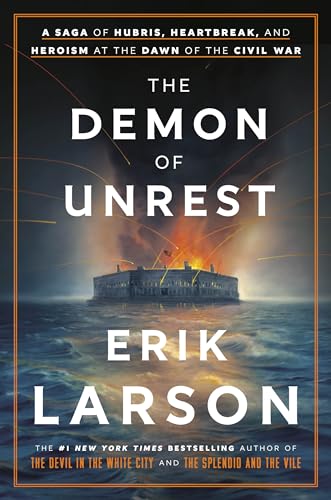The Failure of Political Compromise
Despite numerous attempts at compromise, political leaders on both sides proved unable to prevent war.

Book summary
by Erik Larson
A Saga of Hubris, Heartbreak, and Heroism in the Civil War's First Year
A gripping account of the months leading up to the Civil War
Topics
Read this book chronologically, paying attention to how Larson builds tension through the sequence of events. Use Readever's AI to explore the historical context and primary sources that inform the narrative. After each chapter, consider how the decisions and miscalculations of historical figures might have changed the course of history. Use the highlighting feature to mark particularly insightful analysis of political and military strategy.
Things to know before reading
The Demon of Unrest chronicles the five months between Abraham Lincoln's election in November 1860 and the outbreak of the Civil War in April 1861. Erik Larson brings his signature narrative style to this pivotal period, showing how political tensions, personal ambitions, and miscalculations led the nation to war. The book focuses on key figures including Lincoln, Jefferson Davis, and Major Robert Anderson at Fort Sumter, revealing the human drama behind the historical events.
*The Demon of Unrest* reveals how a series of political failures, personal ambitions, and tragic miscalculations turned a political crisis into America's bloodiest war.
Despite numerous attempts at compromise, political leaders on both sides proved unable to prevent war.
The road to war was paved with personal ambitions, fears, and miscalculations.
Miscommunication and information delays contributed significantly to the escalation toward war.
The crisis at Fort Sumter became the focal point where military and political considerations collided.
Ready to continue? Launch the Readever reader and keep turning pages without paying a cent.
This book offers a gripping, minute-by-minute account of the events that led to the Civil War, bringing historical figures to life with Larson's trademark narrative flair. You'll understand how political failures, personal ambitions, and missed opportunities turned a political crisis into a devastating war. The book provides both historical insight and compelling storytelling, making complex events accessible and dramatic.
Key idea 1
Despite numerous attempts at compromise, political leaders on both sides proved unable to prevent war.
Larson shows how the political system that had previously managed sectional conflicts broke down completely in 1860-1861. Compromise efforts failed due to ideological rigidity, political posturing, and the inability to imagine the scale of the coming conflict.
Remember
Key idea 2
The road to war was paved with personal ambitions, fears, and miscalculations.
Larson focuses on the human element of history, showing how individual personalities, relationships, and psychological factors influenced the course of events. The book reveals that history is shaped not just by abstract forces but by real people making difficult decisions.
Remember
Key idea 3
Miscommunication and information delays contributed significantly to the escalation toward war.
In an era before instant communication, delays in transmitting information and misunderstandings of intentions played a crucial role in the crisis. Larson shows how the limitations of 19th-century communication technology affected decision-making.
Remember
Key idea 4
The crisis at Fort Sumter became the focal point where military and political considerations collided.
Larson examines how the military situation at Fort Sumter became intertwined with political calculations, showing how military actions and political decisions influenced each other in the lead-up to war.
Remember
Sign in to Readever to keep reading with AI guidance, instant summaries, and synced notes.
Erik Larson's signature approach to history—combining rigorous research with narrative storytelling—is particularly effective in The Demon of Unrest. By focusing on a compressed time period and building tension chronologically, Larson creates a sense of immediacy that makes historical events feel urgent and dramatic. His technique demonstrates how narrative history can make complex political and military events accessible to general readers.
One of Larson's strengths is his ability to bring historical figures to life as complex, three-dimensional characters. In The Demon of Unrest, he portrays Abraham Lincoln, Jefferson Davis, Major Robert Anderson, and other key figures with psychological depth, showing their doubts, ambitions, and personal struggles. This character-driven approach helps readers understand that history is made by real people facing difficult decisions.
While the book is primarily narrative, Larson also provides insightful analysis of why events unfolded as they did. He examines the structural failures of the political system, the role of communication limitations, and the psychological factors that influenced decision-making. The book offers both the drama of events and thoughtful interpretation of their significance.
Larson's research is evident throughout the book, with extensive use of primary sources including letters, diaries, newspapers, and official documents. He skillfully integrates these sources into the narrative, allowing historical figures to speak in their own voices while providing necessary context for modern readers.
Although focused on events from over 160 years ago, The Demon of Unrest has clear relevance to contemporary political challenges. The book's exploration of political polarization, the failure of compromise, and the escalation of conflict offers lessons for understanding modern political crises and the importance of maintaining democratic institutions.
Start reading The Demon of Unrest for free and unlock personalized book journeys with Readever.